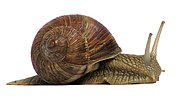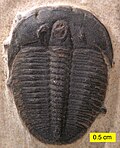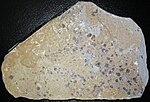Wiwaxia is a genus of soft-bodied animals that were covered in carbonaceous scales and spines that protected it from predators. Wiwaxia fossils—mainly...
35 KB (3,948 words) - 04:36, 17 May 2024
Halwaxiida (section Wiwaxia and Odontogriphus)
combining the names of two members of the proposed group, Halkieria and Wiwaxia. The group was defined as a set of Early to Mid Cambrian animals that had:...
43 KB (4,340 words) - 05:18, 8 November 2023
Shale organisms, such as Canadia, may also have polychaete affinities. Wiwaxia, long interpreted as an annelid, is now considered to represent a mollusc...
30 KB (3,237 words) - 15:40, 13 April 2024
common spongelike animal called Chancelloria; an armored slug-like form Wiwaxia; an armored worm with a pair of brachiopod-like shells Halkieria; and another...
8 KB (837 words) - 17:20, 6 January 2024
"great aunt" of annelids and Wiwaxia was an "aunt" of annelids. Their claim of a close relationship between halkieriids and Wiwaxia was based on both groups'...
63 KB (6,415 words) - 15:30, 13 May 2024
that Odontogriphus's feeding apparatus, which is "nearly identical" to Wiwaxia's, is an early version of the molluscan radula, a chitinous "tongue" that...
30 KB (3,131 words) - 02:32, 9 December 2023
than "probable bilaterian". There is an even sharper debate about whether Wiwaxia, from about 505 million years ago, was a mollusc, and much of this centers...
27 KB (2,672 words) - 00:03, 3 January 2024
"probable bilaterian", if that. There is an even sharper debate about whether Wiwaxia, from about 505 million years ago, was a mollusc, and much of this centers...
93 KB (9,446 words) - 12:00, 14 May 2024
has been proposed to be a member of the order Phyllodocida along with Wiwaxia, another organism from the Burgess Shale. Both were placed in a new superfamily...
5 KB (642 words) - 18:46, 5 January 2024
sclerites are very similar to those of its Burgess Shale contemporary Wiwaxia. Its shell is very similar to: one of the two Burgess Shale shell types...
13 KB (920 words) - 11:28, 7 February 2024
Butterfield, N. J. (1990). "A reassessment of the enigmatic Burgess Shale fossil Wiwaxia corrugata (Matthew) and its relationship to the polychaete Canadia spinosa...
11 KB (1,250 words) - 14:18, 15 January 2024
among Aplacophora, Polyplacophora, Gastropoda, and the Cambrian fossil Wiwaxia corrugata". Journal of Morphology. 257 (2): 219–245. doi:10.1002/jmor.10121...
28 KB (3,289 words) - 15:17, 26 October 2023
Hyolitha, Nematomorpha, Phoronida, and Chordata. Possible molluscs include Wiwaxia and Nectocaris. About one in eight animals are problematic forms of uncertain...
29 KB (2,887 words) - 16:42, 14 March 2024
academic who has so far published articles placing Wiwaxia closer to polychaetes, stated that Wiwaxia′s two-row feeding apparatus could not have performed...
94 KB (9,327 words) - 19:04, 26 April 2024
There has been vigorous debate about whether the Burgess Shale fossil Wiwaxia was a mollusc or an annelid. Polychaetes diversified in the early Ordovician...
88 KB (8,998 words) - 15:25, 15 April 2024
"Ontogeny, morphology and taxonomy of the soft-bodied Cambrian 'mollusc' Wiwaxia". Palaeontology. 57 (1): 215–229. Bibcode:2014Palgy..57..215S. doi:10.1111/pala...
15 KB (1,502 words) - 23:45, 10 February 2024
genus of bizarre stem-group arthropod distantly related to the radiodonts. Wiwaxia, a genus of possible mollusk that had copious numbers of carbonaceous scales...
43 KB (4,699 words) - 10:15, 20 March 2024
Clockwise from top left: Marrella, Hallucigenia, Waptia, Sidneyia, Anomalocaris, Olenoides, Ottoia, Wiwaxia...
20 KB (2,076 words) - 02:30, 1 October 2023
arthropod class. Organisms such as the five-eyed Opabinia and spiny slug-like Wiwaxia were so different from anything else known that Whittington's team assumed...
135 KB (15,556 words) - 06:06, 16 May 2024
Butterfield, N.J. (1990). "A reassessment of the enigmatic Burgess Shale fossil Wiwaxia corrugata (Matthew) and its relationship to the polychaete Canadia spinosa...
72 KB (1,446 words) - 18:35, 16 April 2024
biology Marine vertebrate List of marine aquarium invertebrate species Wiwaxia Myxozoa were thought to be an exception, but are now thought to be heavily...
63 KB (6,561 words) - 12:36, 6 March 2024
Angeles Times Nov. 28, pp. E1, E6. Dawkins, Richard (1990). "Hallucigenia, Wiwaxia and Friends." Sunday Telegraph Feb. 25; reprinted in A Devil's Chaplain...
13 KB (1,292 words) - 16:14, 29 March 2024
confirmed polyplacophorans date back to the Early Ordovician. Kimberella and Wiwaxia of the Precambrian and Cambrian may be related to ancestral polyplacophorans...
49 KB (4,821 words) - 17:41, 13 May 2024
of the Chaetognaths; whilst teeth would be expected, a similar fossil, Wiwaxia, shows such structures in only 10% of the expected instances, and Anomalocaridids...
10 KB (1,078 words) - 09:33, 22 March 2024
Varied soft bodied organisms are also locally preserved, including Naraoia, Wiwaxia and Hallucigenia. Marjum Formation 502 Ma Western Utah, US A site known...
143 KB (6,760 words) - 06:16, 15 May 2024
from Cambrian sediments include the minute scales of priapulid worms, Wiwaxia sclerites, and arthropod feeding parts, for example. These organisms are...
7 KB (754 words) - 16:55, 5 January 2024
soft bodied organisms are locally preserved, a fauna (including Naraoia, Wiwaxia and Hallucigenia) and preservation style (carbonaceous film) normally associated...
17 KB (1,386 words) - 10:39, 20 March 2024
within the coeloscleritophorans: the Sachitids, to which Halkieria and Wiwaxia belong, and the Chancellorids. The Ediacaran fossil Ausia has been touted...
2 KB (267 words) - 01:18, 2 February 2024
would have been a food source for such organisms as Odontogriphus and Wiwaxia. Carroll Lane Fenton (1943). "Pre-Cambrian and Early Paleozoic algae"....
3 KB (190 words) - 01:40, 21 January 2023
R. (2012). "Mouthparts of the Burgess Shale fossils Odontogriphus and Wiwaxia: Implications for the ancestral molluscan radula". Proceedings of the Royal...
26 KB (2,859 words) - 16:03, 6 April 2024























